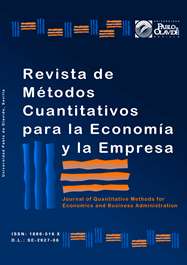Ordinal treatment of qualitative scales used by the Center for Sociological Research
DOI:
https://doi.org/10.46661/revmetodoscuanteconempresa.3788Keywords:
surveys, questionnaires, qualitative scales, imprecision, CISAbstract
Qualitative scales formed by linguistic terms are used by different disciplines to determine preferences and different aspects of individuals’ lives. Although it is usual to assign numbers to the response categories of scales, it is not suitable when individuals perceive different proximities between the consecutive categories of the scale, that is, when scales are not uniform.
In this paper, an ordinal procedure is proposed to order a set of alternatives from the assessments given by a group of individuals through a qualitative scale not necessarily uniform. This procedure is based on ordinal proximities between the response categories of scales. The proposed procedure is illustrated with an example taken from the Barometer of the Center for Sociological Research of May 2011.
Downloads
References
Balinski, M., & Laraki, R. (2007). A theory of measuring, electing and ranking. Proceedings of the National Academy of Sciences of the United States of America, 104, 8720-8725.
Balinski, M., & Laraki, R. (2011). Majority Judgment: Measuring Ranking and Electing. Massachusetts: MIT Press.
Beyth-Marom, R. (1982). How probable is probable? A numerical taxonomy translation of verbal probability expressions. Journal of Forecasting, 1, 257-269.
Díaz de Rada, V. (2004). Problemas de representatividad en las encuestas que utilizan muestreos probabilísticos. Papers, 74, 45-66.
Díaz de Rada, V. (2015). Calidad de los datos de preguntas de batería en encuestas presenciales: una comparación de un estudio con cuestionario en papel y en formato electrónico. Revista Española de Investigaciones Sociológicas, 152, 167-177.
Durán, A., Ocaña, A.C., Cañadas, I., & Pérez, F.J. (2000). Construcción de cuestionarios para encuestas: el problema de la familiaridad de las opciones de respuesta. Metodología de Encuestas, 2(1), 27-60.
Epstein, L.G. (1999). A definition of uncertainty aversion. The Review of Economic Studies, 66(3), 579-608.
Fleiss, J.L., Levin, B., & Paik, M.C. (2003). Statistical Methods for Rates and Proportions. New Jersey: Wiley and Sons.
Franceschini, F., Galetto, M., & Varetto, M. (2004). Qualitative ordinal scales: the concept of ordinal range. Quality Engineering, 16, 515-524.
García-Lapresta, J.L., & González del Pozo, R. (2019). An ordinal multi-criteria decision-making procedure under imprecise linguistic assessments. European Journal of Operational Research, 279, 159-167.
García-Lapresta, J.L., González del Pozo, R., & Pérez-Román, D. (2018). Metrizable ordinal proximity measures and their aggregation. Information Sciences, 448-449, 149-163.
García-Lapresta, J.L., & Pérez-Román, D. (2015). Ordinal proximity measures in the context of unbalanced qualitative scales and some applications to consensus and clustering. Applied Soft Computing, 35, 864-872.
García-Lapresta, J.L., & Pérez-Román, D. (2018). Aggregating opinions in non-uniform ordered qualitative scales. Applied Soft Computing, 67, 652-657.
Grossi, D., & Pigozzi, G. (2014). Judgment Aggregation: A Primer. Synthesis Lectures on Artificial Intelligence and Machine Learning. Morgan and Claypool.
Kennedy, R., Riquier, C., & Sharp, B. (1996). Practical applications of correspondence analysis to categorical data in market research. Journal of Targeting, Measurement and Analysis for Marketing, 5(1), 56-70.
Likert, R. (1932). A technique for the measurement of attitudes. Archives of Psychology, 22(140), 1-55.
Lozano, L.M., García-Cueto, E., & Muñiz, J. (2008). Effect of the number of response categories on the reliability and validity of rating scales. Methodology, 4, 73-79.
Mangione, T.W. (1995). Mail Surveys: Improving the Quality. Applied Social Research Methods. Thousand Oaks: Sega Publications.
Matas, A. (2018). Diseño del formato de escalas tipo Likert: un estado de la cuestión. Revista Electrónica de Investigación Educativa, 20(1), 38-47.
Merbitz, C., Morris, J., & Grip, J.C. (1989). Ordinal scales and foundations of misinference. Archives of Physical Medicine and Rehabilitation, 70, 308-312.
Nadler, J., Weston, R., & Voyles, E. (2015). Stuck in the middle: the use and interpretation of mid-points in items on questionnaires. The Journal of General Psychology, 142(2), 71-89.
Pardo, A. (2002). Análisis de Datos Categóricos. Madrid: UNED.
Roberts, F.S. (1979). Measurement Theory. New York: Cambridge University Press.
Silva, L.C. (1997). Cultura Estadística e Investigación Científica en el Campo de la Salud: una Mirada Crítica. Madrid: Ediciones Díaz de Santos.
Stevens, S.S. 1951. Mathematics, Measurement and Psychophysics. Oxford, England: Wiley.
Teigen, K.H., & Wibecke, B. (1999). The directionality of verbal probability expressions: effects on decisions, predictions, and probabilistic reasoning. Organizational Behavior and Human Decision Processes, 80(2), 155-190.
Zimmer, A.C. (1983). Verbal vs. numerical processing by subjective probabilities. En: Scholz, R.W. (ed.). Decision Making under Uncertainty, pp. 159-182. North Holland, Amsterdam.
Downloads
Published
How to Cite
Issue
Section
License
Copyright (c) 2019 Journal of Quantitative Methods for Economics and Business Administration

This work is licensed under a Creative Commons Attribution-ShareAlike 4.0 International License.
Submission of manuscripts implies that the work described has not been published before (except in the form of an abstract or as part of thesis), that it is not under consideration for publication elsewhere and that, in case of acceptance, the authors agree to automatic transfer of the copyright to the Journal for its publication and dissemination. Authors retain the authors' right to use and share the article according to a personal or instutional use or scholarly sharing purposes; in addition, they retain patent, trademark and other intellectual property rights (including research data).
All the articles are published in the Journal under the Creative Commons license CC-BY-SA (Attribution-ShareAlike). It is allowed a commercial use of the work (always including the author attribution) and other derivative works, which must be released under the same license as the original work.
Up to Volume 21, this Journal has been licensing the articles under the Creative Commons license CC-BY-SA 3.0 ES. Starting from Volume 22, the Creative Commons license CC-BY-SA 4.0 is used.










